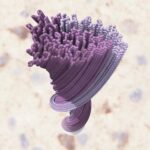
Cryo-EM analysis of TDP-43 filaments by Benjamin Ryskeldi-Falcon’s group in the LMB’s Neurobiology Division has revealed the atomic structure of the characterising feature of neurodegenerative diseases ALS and FTD.
MRC Laboratory of Molecular Biology
One of the world's leading research institutes, our scientists are working to advance understanding of biological processes at the molecular level - providing the knowledge needed to solve key problems in human health.